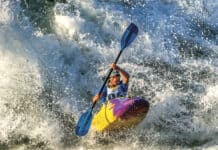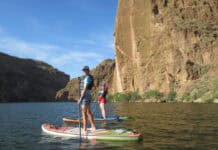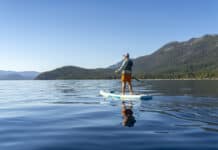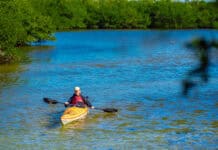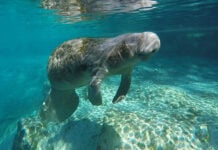Sounds grand doesn’t it? Of course—it’s the Grand River. The Grand flows 300 km from its northern source in Dundalk to its mouth at Lake Erie in the town of Port Maitland. Along the way, it passes through the backyard of Canada’s most densely populated region, some 100 km southwest of Toronto and easily accessible from highways 401 and 403. Roughly 6 million people live within an easy hour’s drive of this paddling paradise, but you’re unlikely to encounter any of them on this hidden jewel.
Flowing through both the exquisite beauty of Ontario’s largest preserved Carolinian forest and a number of towns and cities, the Grand offers a rare contrast of urban and wild settings. With an early start there’s a good chance of glimpsing deer, raccoon, beaver and coyote. And you may become tired of counting the plentiful bird species including blue herons, cranes, ducks, red tailed hawks and even bald eagles.
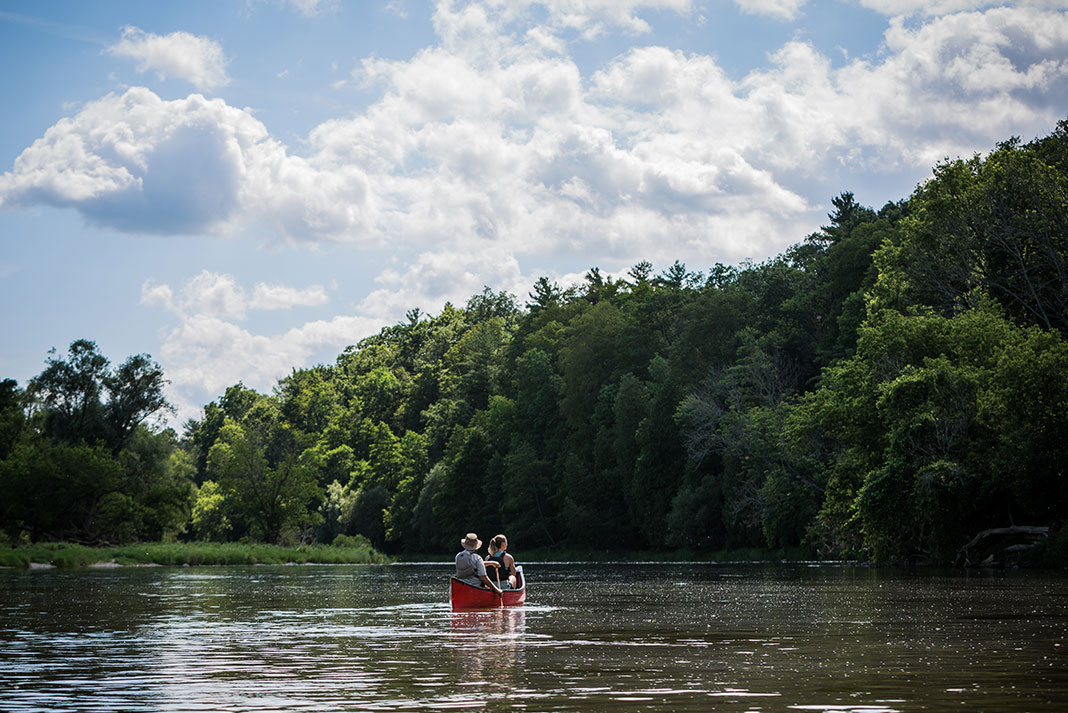
Canada added the Grand River to its exclusive list of Heritage Rivers in 1994, as much for its human heritage as for the preservation of its unique natural setting.
Evidence of aboriginal culture dating back 10,000 years has been uncovered along the banks of this ancient human highway.The 1800s saw the completion of a series of dams and locks, which allowed the Grand River Navigation Company to warp scows and barges laden with commerce to and from the many settlers in the bustling riverside communities—settlements that grew into present-day cities like Kitchener, Cambridge, Brantford and Paris. The canals and barges are long gone, but several dams remain, regulated by the Grand River Conservation Authority (GRCA) to ensure adequate flows year-round for water quality and recreational purposes.
If you’re interested in Grand River paddling—whether by canoe, kayak, paddleboard or raft—read on to learn more and plan your trip.
Why go?
The beauty and serenity of this river system is the biggest surprise… The most common comment from new paddlers is, “I can’t believe I am one hour from Toronto and paddling in a setting like this!”
Keep an eye out for…
Bald eagles, osprey, beaver, mink, numerous song birds, vultures, turtles, fish and deer.
Best paddling route
Canoe Grand River Cambridge to Paris
While much of the lower half of the Grand is navigable by kayak, the most enjoyable section is the 18 km between the south end of Cambridge and the picturesque town of Paris (named after plaster-of-paris and not the famous French city). This section’s swifter current and steep forested bluffs block out signs of city life, intensifying the wilderness experience, while the shallow water negates any chance of encountering the drone of power boats.
Start your adventure by launching at the put-in beside the Petro-Canada gas station just south of Cambridge on Hwy 24 (you can find the parking lot here). Here you’ll find free parking and a ramp to the river. Ten minutes adrift down the river and you’ll leave behind any signs of urban sprawl. This is the fastest section of the river, other than a small stretch of some serious whitewater up north in the Elora Gorge. Occasional sets of minor rapids offer an exciting twist to the serene drift of the river current. Paddlers cruising in kevlar or museum-quality kit boats might opt for a plastic rental boat to avoid the unavoidable scratches and dents. A leisurely two- to three-hour paddle will take you to the lift-out and portage at river-left just under the railway bridge, a hundred yards above Penman’s Dam in Paris.
While there are scattered homes and farms visible near the city boundaries at each end of this trip, you’ll see very little evidence of human influence in-between with the exception of two car bridges and the massive abutments of an abandoned CNR railway bridge. Watch for the ruins of an old mill hiding in the trees on the left bank just before the second bridge near Glen Morris.
The occasional muffle of human voices echoing from river-left might be mistaken for the ghosts of paddlers past but are merely the sounds of hikers and bikers enjoying the Cambridge–Paris Rail Trail which follows an old rail line along the river for this entire section. There are several lookouts from the trail with excellent views of the river, and the pathway allows paddlers to opt for a bike shuttle instead of the two-car shuffle. You can leave your bike chained to a tree near the take-out in Paris, then lock your kayak there when it’s time to ride the 18 km back upriver to your car.
Alternatively, you can make shuttle and/or rental arrangements through one of the local outfitters or even catch a cab back to the Petro-Canada station.
Whichever way you choose to arrange your shuttle, make sure to check out downtown Paris before you head home. Follow the trail from the portage to the bridge across the river. The businesses back onto the river and the cars still park diagonally on the main street. Check out one of the local diners such as Stillwaters Plate & Pour and Cobblestone Public House.
Where to stay
The Grand offers three- to seven-hour canoe trips as well as multi-day trips. Paddlers can camp on the riverside during multi-day trips. There are also many hotels, B&B and campsites nearby.
Campgrounds
Hotels and B&Bs
Outfitters
Gear rentals, guided tours, trip planning and shuttles are all offered by the following outfitters along the Grand:
Canoeing The Grand
- Location: Kitchener, Ontario
- Section of river: Elora to Cambridge
Grand River Rafting
- Location: Paris, Ontario
- Section of river: Cambridge to Brant Park
Grand Experiences Outdoor Adventure Company
- Location: Paris, Ontario
- Section of river: Cambridge to Brant Park
Access points
- Elora Gorge Conservation Area
- Wilson’s Flats, Inverhaugh
- Golf Course Road, Conestogo
- Moyer’s Landing, Blair
- Riverbluffs Park, Cambridge
- Cambridge to Paris Rail Trail parking lot, Cambridge
- Glen Morris
- Penman’s Dam, Paris
- Bean Park, Paris
- Brant Conservation Area
- Gilkison’s Flats, Brantford
- Cockshutt Bridge, Brantford
- Kinsmen Park, Caledonia
- York Park, Caledonia
- Bob Baigent Park, Cayuga
- Byng Island Conservation Area
For more information about access points, read here.
This article was first published in Adventure Kayak‘s Winter 2003 issue. Subscribe to Paddling Magazine’s print and digital editions here , or browse the archives here.
Wilderness feel, easy access from the city. | Photo: Destination Ontario


